October 15, 2020
 by Gerard Tonti / October 15, 2020
by Gerard Tonti / October 15, 2020

Your nonprofit needs a healthy mix of new and old donors to ensure there’s enough fundraising revenue to accomplish mission-critical goals.
While we all wish we could retain 100% of the donors we acquire, there is a natural lapse rate that must be accounted for in your fundraising strategy. Plus, healthy acquisition is necessary for growth.
If your current donor acquisition strategies aren’t working as well as you’d like, it’s time for an upgrade. Modern engagement technologies and new industry best practices can help your organization acquire donors more efficiently.
In this guide, we’ll take a comprehensive look at some of the best donor acquisition strategies including:
But before we dive into our best advice, we’ll cover the basics of donor acquisition to make sure we’re all on the same page.
Donor acquisition is the process of securing new donors for your nonprofit. While acquisition isn’t as much of a buzzword in the sector as retention, both are critical components of a healthy and sustainable organization. Both retention and acquisition strategies rely on similar tactics to be successful, but acquisition is often more difficult and expensive.
Despite the challenges and costs associated with donor acquisition, no organization can ignore it. Because attrition rates are so high, development professionals must constantly work to find new donors in order to grow and thrive.
Clearly, donor acquisition is an essential task for every nonprofit. To know whether you’ve been successful in your mission to improve donor acquisition, you have to create a concrete plan. Gather and evaluate your nonprofit’s recent donor acquisition data. While the data available will depend on your organization’s longevity and level of record-keeping, aim for around five years of data.
Using this data, you can estimate your current donor acquisition cost and set benchmarks based on your history of new donors.
These pieces of information will allow you to set a realistic goal for your organization. We recommend a SMART goal, which stands for:
Based on the data you uncover, you might set a SMART donor acquisition goal like, “Acquire 200 new donors between October 1st and January 1st.”

No matter what kind of goal you have in mind, making data-driven decisions will lead to better results. To build a solid foundation of usable data, we recommend implementing strategies to conduct new research and leverage existing information. For instance, you could send a survey to your existing donors asking how they discovered your organization or add it as a multiple-choice question on your online donation form.
Powerful constituent relationship management (CRM) software is a key component of a strong donor cultivation strategy.
In addition to helping you optimize your relationships with loyal donors, CRM systems help you build relationships with new supporters. When you are trying to convert a prospect into a first-time donor, a CRM can help you keep track of important personal information and record engagement activities.
Every organization has its own unique needs, so you’ll want to find CRM software that is dedicated to nonprofits and customizable. This guide to choosing the best nonprofit CRM explains that a strong CRM tool provides a centralized view of donor activity, campaign success, and fundraising for both online and offline sources.
By using this holistic view of your nonprofit's information, you can better understand where the opportunities for improvement lie in your communication and acquisition strategies. In order to get the most out of your CRM, ensure you have data hygiene protocols in place. This will help your data stay clean, consistent, and error-free, both for new and existing supporters.
Prospect research is a useful way to find potential donors and supporters for your nonprofit. Depending on the size of your organization, you can conduct this research in-house, work with a consultant, or use a specialized screening tool.
No matter which option you choose, prospect research involves looking at two types of data:
Taken together, this information can help you identify new donors in your community. As a subset of prospect research, wealth screening can also help you identify which donors have the highest capacity of giving to your organization. This is particularly important for identifying potential new major donors and prioritizing outreach.
A feasibility study is designed to ascertain whether a nonprofit is ready to tackle a large project. Often, a feasibility study is thought of purely as a way to determine a fundraising goal, but it can also help identify potential donors. It can enable your organization to map out its current donor population and identify individuals who may be able to contribute to your mission.
It can also help your nonprofit in other ways, including:
While a feasibility study can generate a lot of useful information, it’s not a perfect fit for every organization. Feasibility studies are best for larger nonprofits with a strong fundraising track record and are generally conducted before a major fundraising initiative.
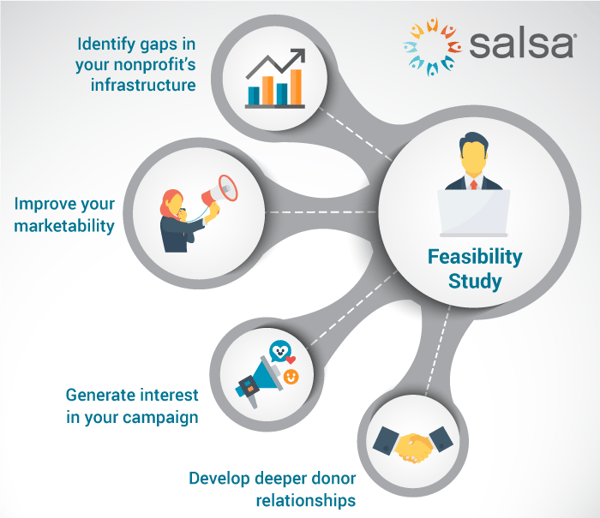
Looking at your previous donor acquisition data, you probably noticed a few spikes or trends. Don’t ignore these!
For all nonprofits, the last few months of the year tend to correlate with increased donations. This is due to an elevated feeling of generosity around the holidays as well as more concrete financial reasons like tax benefits.
Craft targeted year-end appeals to take advantage of peak giving times. This could include a specialized #GivingTuesday campaign that targets new donors or another holiday-related strategy.
Additionally, take your organization’s typical annual ebbs and flows into consideration. For example, if you normally host a peer-to-peer event that brings in a lot of new donors during the spring months, be sure to factor that into your strategy.
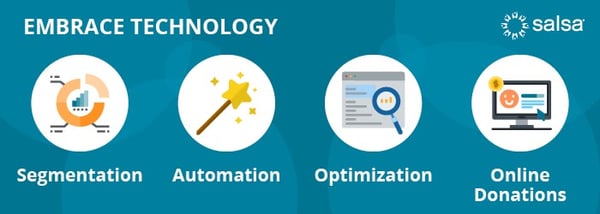
You probably already have the key components of your nonprofit tech stack in place. But are you using them to their maximum capacity?
By effectively leveraging your tools as well as embracing new opportunities (such as the automated workflow features in your CRM), you’ll be able to make smarter decisions to acquire new donors. Technology, like peer to peer fundraising software can help your nonprofit save time and money by working more efficiently. We recommend incorporating strong digital strategies to acquire new donors.
Segmenting prospective donors based on key criteria can help you craft a more targeted (and effective) outreach strategy.
Any time you segment supporters or potential supporters, it opens the door for deeper personalization and increased emotional connections. When you’re speaking to a specific group rather than your entire audience, your tailored message is more likely to resonate.
Nonprofits often think about segmentation with regard to their long-time donors, but it can also be useful for soliciting new donors who may have only briefly interacted with your organization.
For instance, if you’re trying to convert new newsletter subscribers into first-time donors, you may want to segment prospects based on how they found your organization if that data is available. Or you could segment registered attendees for an upcoming event based on their historical gift size to other nonprofits.
There are many other useful ways to group prospects, including:
A full-featured nonprofit CRM will allow you to pick from predefined segments or create categories that are specific to your organization’s strategy. These segments will help you convert prospects into donors more effectively.
Today’s powerful automation technologies can ensure opportunities for donor acquisition never fall through the cracks. With automation options, you can contact the right prospect, at the right time, with the right message.
For example, your engagement platform may support a useful communication strategy known as a drip email campaign. With a drip campaign, you can send a prospect a predefined sequence of emails that is triggered by one action and finishes with another. For example, an event attendee could receive a stream of emails triggered by an event confirmation, continuing with information about your mission until a donation is made.
You can also use automation technology to extract engagement data from marketing campaigns and add it directly to donor profiles in your CRM. This ensures the relevant information is exactly where you need it without any manual data entry. In any case, automation saves valuable time for your team members, giving them more time and energy to focus on mission-critical projects.
Technology can help you to assess what is working and not working in your current communication strategy. By looking at key engagement metrics like click-through rate (CTR), you can determine which of your strategies are most successful.
For example, if you send out a newsletter that ends up having an unusually low CTR, you may try sending the next one on a different day or time to see if that boosts performance. Many marketing software solutions will allow you to analyze trends across engagement metrics in order to optimize your outreach. This will help you craft communications that successfully attract new donors.
You can also utilize A/B testing to accomplish this analysis. With A/B testing (also known as split testing), you divide your audience to receive largely the same piece of communication but with some key differences. This could be a separate email subject line, an adjusted CTA, or a different time of day for a social media post. Then, you’ll have the isolated information needed to make a data-driven change.
Nonprofits are relying on virtual tools to execute a wide range of activities. But even without social distancing parameters in place, online platforms are critical for donor acquisition. You have to meet prospects where they are.
Innovative online fundraising platforms should be a key component of your donor acquisition strategy. By leveraging the right tools, you’ll be well-equipped to reach new audiences and make a positive first impression.
We recommend investing your energy into online platforms with features such as:
By incorporating these digital tools into your donor acquisition plans, you’re sure to increase your odds of success.
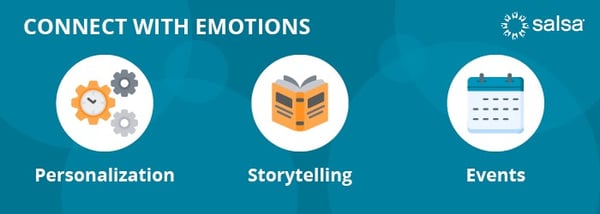
Especially when you’re trying to connect with new prospects, supporters want to see that you care about them as people, not as piggy banks.
Doubling down on emotional appeals can help boost your donor acquisition rate. While we aren’t suggesting you guilt-trip your supporters to secure donations, a few tugs of the heartstrings can be very powerful. Work to integrate an emotional touch both in your mission-based messaging and in your outreach strategies.
Earlier, we discussed building a strong foundation of data to support your donor acquisition strategy. This is one key area where you can leverage that data for success!
When your outreach to potential donors is personalized, it is more relevant and engaging – maximizing the potential for support. You can use whatever information you have on hand in your donor database, from basic data like a preferred name to more specific metrics like past event attendance.
This could be more difficult for engaging potential new donors than longtime supporters since you’ll have less information available to work with. However, it’s still an avenue worth exploring.
After all, simply addressing an email to the recipient’s first name increases open rates by 25%. And if you have the automation technology available to automatically insert names, this is a super simple tweak that could make a big impact.
Across all of your communication channels, you should have sound storytelling strategies in place. You need to convey your mission as a real problem affecting real people, rather than just an abstract concept. This will help new supporters get on board.
One way to do this is by explaining the concrete outcomes generated by a donor’s generosity. Translate dollar amounts into the tangible impact they have on your mission. For example, you might say that a $50 donation to your animal shelter can cover the vaccination costs for one dog. This establishes a powerful narrative of giving.
Depending on the nature of your nonprofit, you may also be able to share testimonials from your constituents. Potential donors could be motivated by hearing about your mission from the perspective of those who feel the impact.
Face-to-face interactions are a key way to connect with prospects on a personal level, but virtual events are still a valuable opportunity.
Utilize in-person (when safe) or virtual events including charity auctions, conferences, and benefit dinners to establish connections with new individuals. Prospects will be able to learn more about your mission and the work you do. By understanding the impact they would be able to make, they may feel more inclined to donate. Hopefully, attending one of your events will kick off a long and mutually beneficial relationship.
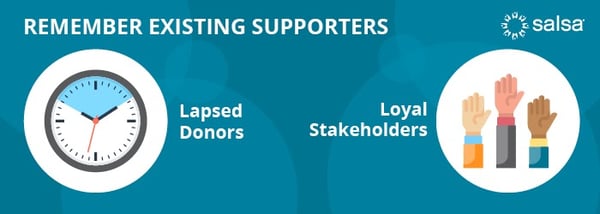
While the point of donor acquisition is to grow your base of support, it can also include some donors who may already be familiar to your organization. Don’t ignore key groups like lapsed donors and your most loyal supporters, as these individuals represent high-impact opportunities with a potentially low lift.
While they’re not brand-new donors, supporters who have donated in the past but are no longer active are still worth some of your attention. Lapsed donors are valuable because you already know that they’re interested in your organization and care about your mission.
Every organization has a different definition of what length of time constitutes a lapse, so make sure you have a guideline established. A good donor database will include reporting features to help you identify each lapsed donor based on whatever criteria you set.
Once you’ve developed a list of lapsed donors, it’s time to reconnect. Here are a few best practices to keep in mind for engaging lapsed donors:
Re-acquiring supporters who you’ve lost touch with can still help to strengthen your overall donor base, and these techniques will help.
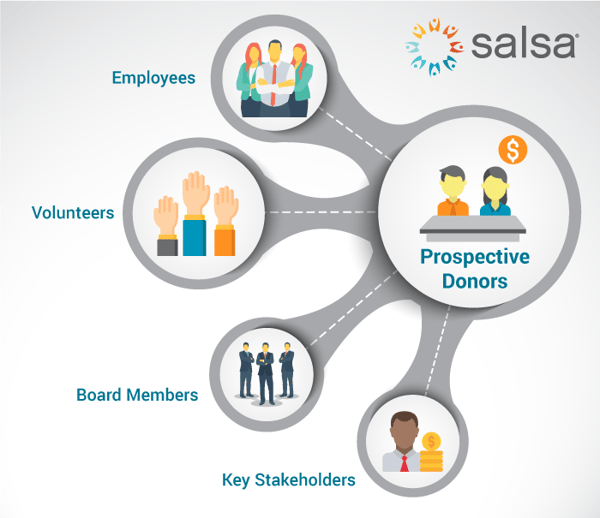
The prospects closest to home are those who are already loyal to your nonprofit. Reach out to your board members, volunteers, employees, and other key stakeholders to see how they could increase their impact on your mission.
Invite individuals who have demonstrated dedication to your organization to spread the word to friends and family. Because you already know they care about your mission, you can count on them for continued support. Reach out to them to share your goals and plans for donor acquisition.
Even if you don’t make a specific fundraising ask in the conversation, some supporters may be motivated to increase their giving levels. Although this isn’t a way of acquiring new donors, it’s still a useful strategy to boost much-needed funds.
No matter how successful your donor stewardship and retention strategies are, your nonprofit still depends on new donors to fulfill your mission. Donor acquisition is a critical component of any sustainable nonprofit and it’s necessary for nonprofit growth. With the strategies from this guide in mind, your nonprofit will be able to keep making an impact for years to come.
Gerard Tonti is the Senior Creative Developer at Salsa Labs, a fundraising software company for growth-focused nonprofits. Gerard's marketing focus on content creation, conversion optimization, and modern marketing technology helps him coach nonprofit development teams on digital fundraising best practices.
Early in my fundraising career, I confessed to my boss that I had no idea how to ask for...
 by Dominick Duda
by Dominick Duda
Getting a donor is half the battle; the other half is keeping them.
 by Gerard Tonti
by Gerard Tonti
Your nonprofit hosts some incredible events throughout the year. You plan and plan to make...
 by Jay Love
by Jay Love
Early in my fundraising career, I confessed to my boss that I had no idea how to ask for...
 by Dominick Duda
by Dominick Duda
Getting a donor is half the battle; the other half is keeping them.
 by Gerard Tonti
by Gerard Tonti


.jpg?width=400&name=Bloomerang_G2-Crowd_10-Strategies-to-Organize-Donors-After-a-Fundraising-Event_Feature%20(1).jpg)